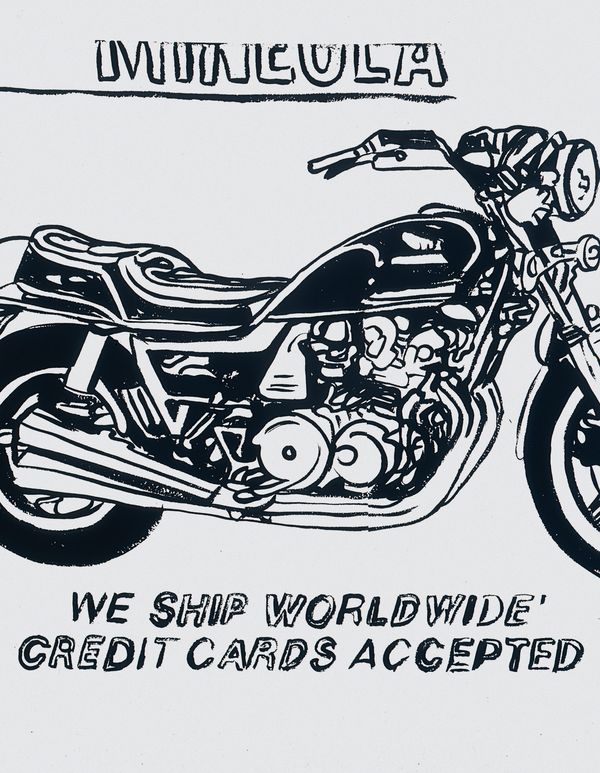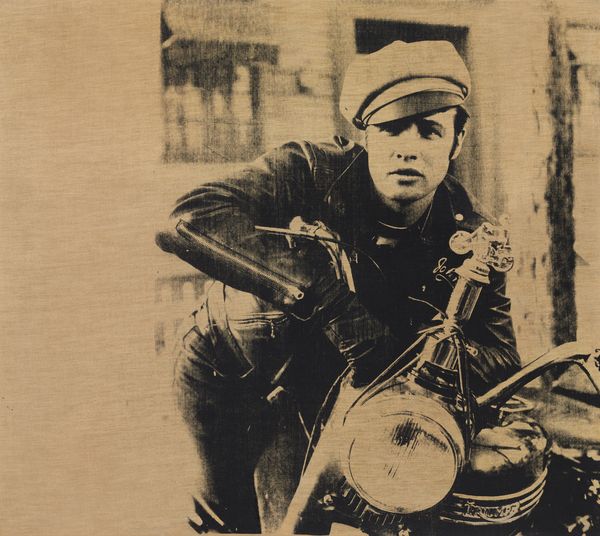Andy Warhol Mineola Motorcycle (positive), 1985-96 (detail). Dynthetic polymer paint and silkscreen ink on canvas. Stamped by The Andy Warhol Art Authentication Board.
Standing almost two metres tall, Andy Warhol's Mineola Motorcycle (positive) is one of the largest paintings of his oeuvre. Rendered by hand in stark black on white, this motorbike ad has been granted the glamour of monumentality, appearing on a bill-board scale.
By appropriating an advertisement, Warhol is exploring the type of ephemeral imagery that he had immortalised, turning them into the cornerstones of Pop Art. The restrained palette adds an emphatic dynamism to the image, the black paint on its luminous white background lending it an incredible visual impact that slyly recalls the Abstract Expressionist paintings of Franz Kline.
The theme of the motorbike was perfect for Warhol, tied up as it was with notions of freedom and rebellion...
Andy Warhol Marlon, 1966. Silkscreen on canvas. Private collection. Private Collection/Bridgeman Images © The Andy Warhol Foundation for the Visual Arts, Inc. / Artists Rights Society (ARS), New York
When Mineola Motorcycle (positive) was created around 1985-1986, Warhol had returned to some of the themes and techniques that he had employed to such success at the beginning of his career. The motorcycle can be seen as a reference to the silkscreens of Marlon Brando he had created during the 1960s, taking an iconic still from The Wild One that shows the star kitted out as a biker. In terms of techniques, Warhol used projectors to show images on a picture surface which he would then paint by hand, echoing the way he had painted his original Coca-Cola Bottles and Campbell's Soup Cans.
This hands-on technique also reflected a new interest in the painterly that was inspired by Jean-Michel Basquiat. In the mid-1980s, Basquiat and Warhol created paintings in which each artist added their own elements. As Warhol would comment at the time, in a diary entry from 16 September 1984, "Jean Michel got me into painting differently, so that's a good thing" (The Andy Warhol Diaries, ed. Pat Hackett, New York, 1989).
Warhol's use of this hands-on technique came to prominence in what was to be one of his final great series — The Last Supper. Based on Leonardo's celebrated mural in Milan, these pictures were created using a range of techniques, including several that were hand-painted as Mineola Motorcycle (positive) had been. Indeed, in one of Warhol's largest paintings, The Last Supper (The Big C) from around 1985, now in the Andy Warhol Museum, Pittsburgh, the titular feast is punctuated by images of the same ad that served as the basis of Mineola Motorcycle (positive). "I painted them all by hand—I myself," Warhol explained of the related Last Supper works, as quoted in J.D. Ketner, II's Andy Warhol: The Last Decade. "That's why the project took so long."
The theme of the motorbike was perfect for Warhol, tied up as it was with notions of freedom and rebellion, as encapsulated in Brando's movie. At the same time, Warhol was also keenly aware of the subculture that had grown around the biker look, for instance in the gay scene explored in Kenneth Anger's 1963 film Scorpio Rising. It was the sheer multiplicity of meaning of the image of the biker that doubtless appealed to Warhol. In Mineola Motorcycle (positive), this is underscored by the fact that we are looking at an ad—the notion of the biker rebels roaming the roads is playfully deflated by the declaration that credit cards are accepted.
In Mineola Motorcycle (positive), as in so many of his most iconic Pop paintings, Warhol has managed to create a picture that invokes wit, subcultures and aesthetics, as well as the consumer culture that so fascinated him.


